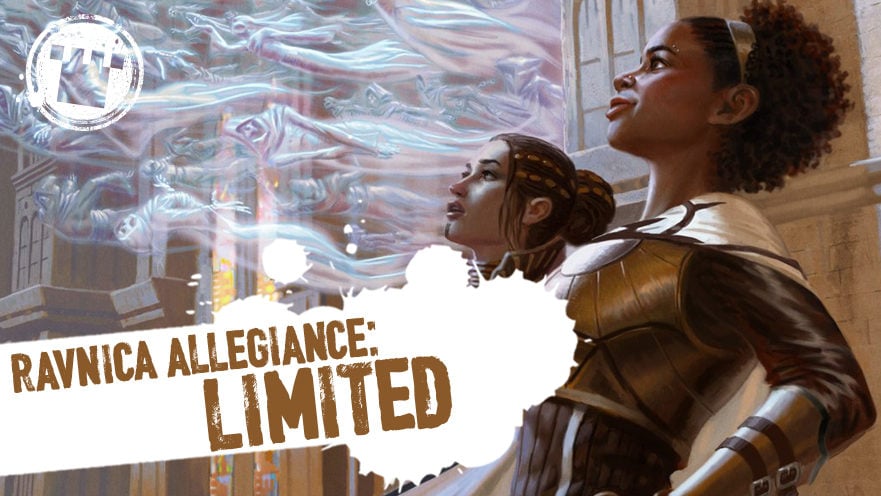It’s hard to believe that it’s only been three weeks since the release of Ravnica Allegiance. For many of us, it’s felt like far longer. Thanks to MTG Arena, we’ve been able to draft Ravnica Allegiance since January 18th, so we’ve had more time than usual to evaluate the format.
If you’re just diving in to Ravnica Allegiance draft or are looking to improve your results in the format, you’re in luck! In this primer, we’ll cover the format’s major archetypes and top-performing cards. (If you’re reading this in the future and Ravnica Allegiance draft has come back to MTG Arena, hopefully this advice still holds true. 😉)
GATES
First, let’s address the elephant… err, Ram in the room.
Five-Color Gates is the most talked-about deck in RNA draft, partly because it just wasn’t on the Arena draft bots’ radar when the set came out. Early in the format, players began noticing that the bots were disinclined to take guildgates, which made powerful “gates matter” uncommons much easier to build around.
The essential ingredients of a good gates deck are as follows:
Gate Colossus
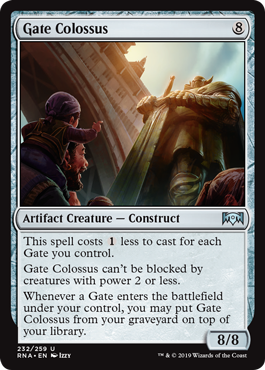
The deck’s premier finisher. Colossus has the highest base power and toughness of any creature in the format, and its second ability helps it dodge creatures with deathtouch. With few exile effects in the format – look out for sideboarded Bring to Trials – Colossus is a recursive threat that will cost even less mana each time you cast it.
Gates Ablaze
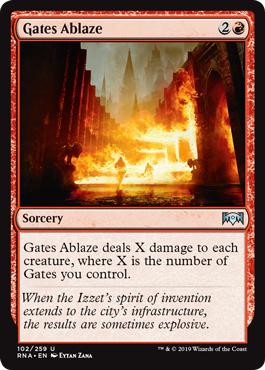
Board-wipes often get a bad rap in limited. They’re only useful when you’re behind, and if you spend your whole turn casting one, your opponent gets to start rebuilding before you do. Fortunately, Gates Ablaze only costs three mana, meaning you can wipe the board and potentially cast another threat in the same turn. Gates is ultimately a control deck, so this type of effect is essential if you’re looking to make it to the late game.
Gatebreaker Ram
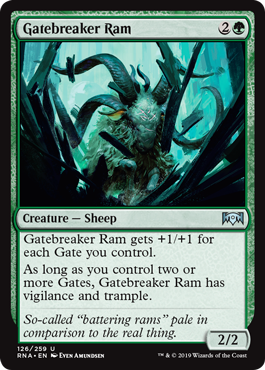
While it doesn’t look as flashy as Gate Colossus, Gatebreaker Ram is arguably the more important threat. Simply put, Gatebreaker Ram is useful at every stage in the game: it’s a great early attacker, a fantastic blocker, and a potent late-game threat, all in one little green package. It can also be the last creature standing after you cast a Gates Ablaze. If you see this uncommon going around, consider taking it.
The Gates
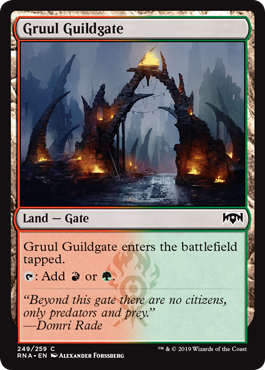
A good Gates deck should have about a dozen guildgates – and, fortunately, they aren’t too hard to come by. Be sure to prioritize Gruul Guildgates, which make mana for both Gatebreaker Ram and Gates Ablaze, but off-color gates often get the job done.
Optional: Gateway Sneak and Archway Angel
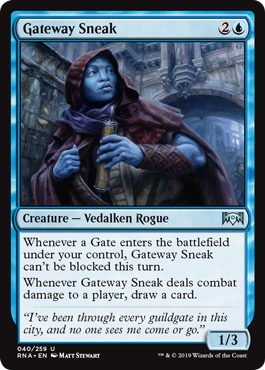
Off-color gates come in handy if you plan on including some additional “gates matter” uncommons. Gateway Sneak can be an unstoppable card-draw engine, but unlike Gatebreaker Ram, it’s not very useful if you fall behind. Conversely, Archway Angel is great when your life total gets too low, but since it lacks Gate Colossus’s cost-reduction clause, you may not always be able to cast it. Look to add one of each of these cards to your deck, if possible, but if you can’t grab any, you won’t be at a huge loss.
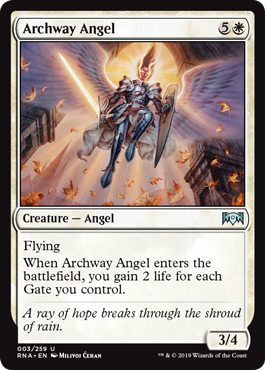
Five-Color Gates is a great archetype to try if you’re drafting on MTG Arena. The deck’s threats are strong and demand answers, and it can come back from behind much easier than most other decks in the format.
If you’re drafting Ravnica Allegiance in person or on Magic Online, however, this deck may not come together as easily, as your fellow drafters will value guildgates much higher than the Arena bots. Plus, the deck’s heavy reliance on uncommons means there may not be enough key pieces to go around if another drafter is trying to draft this archetype.
As always, be sure to pay attention to signals – if you get a late Gatebreaker Ram, take it! It’s a fine card for a Simic or Gruul deck, as long as you have a couple gates to help it out.
GRUUL
Gruul was an early front-runner for strongest guild in the set. With robust creatures at every slot in the mana curve, Gruul can present a fast clock, and the ability to give creatures haste with the Riot mechanic means that the deck can play surprisingly well from behind. Like Boros in Guilds of Ravnica, Gruul has taken on the role of Fun Police: take too long to assemble your synergies, and the game may already be over.
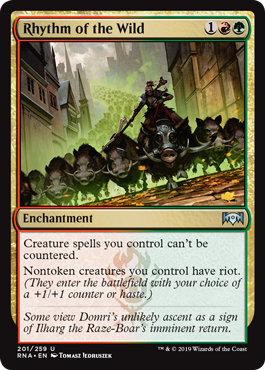
Gruul’s key uncommon is Rhythm of the Wild: a three-mana enchantment that gives all creatures Riot. This slots into Gruul’s curve incredibly well – it’s heaviest hitter, Frenzied Arynx, is a great turn four follow-up – and gives creatures that already have Riot a second instance of the mechanic. Additionally, Rhythm prevents creature spells from being countered, much to the chagrin of your opponent who was holding a Quench.
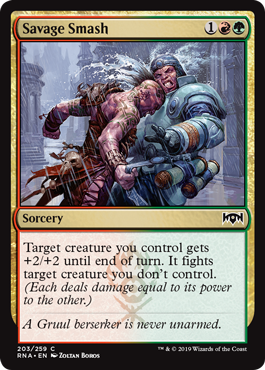
While its creatures are some of the most efficient in the format, Gruul often struggles with removal. Its two dedicated removal spells, Savage Smash and Titanic Brawl, are fantastic in the early game or when you’re slightly ahead, but useless when you can’t keep a creature on the board. A couple copies of Skewer the Critics or Scorchmark can be surprisingly useful here. Gruul can also struggle with flyers, especially if it starts to fall behind, so I’d recommend picking up a copy of Collision // Colossus, if you can. (A Sagittar’s Volley in the sideboard works, too.)
SIMIC
Confession: The Simic deck has been the hardest deck for me to put together in MTG Arena. Maybe the bots value Simic cards too highly, or maybe the deck is too reliant on higher-rarity cards. However, when the stars align, Simic can be one of the most powerful decks in the format.
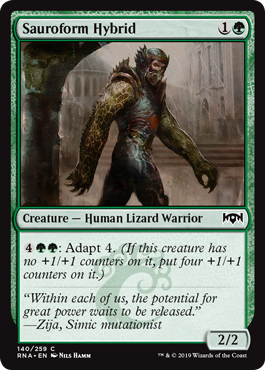
The thing that really sets Simic apart from other archetypes is its mana sinks. These are creatures or spells with activated abilities that you can “sink” mana into when you have nothing else to do, especially later in the game. Simic’s most common mana sink is Sauroform Hybrid, a 2/2 green creature that can become a 6/6 later in the game. (I’ll happily play a few of these in a Gruul deck, too.) This encapsulates Simic’s game plan: get on the board early, gain incremental advantage, and take over the late-game with big creatures.
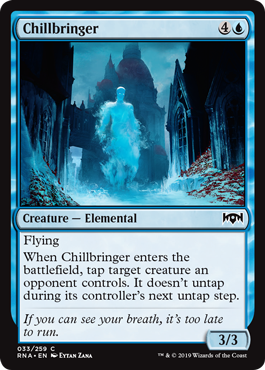
Simic also excels at playing the tempo game: adding threats to the board while setting the opponent back. Chillbringer is the poster child for this type of gameplay; while the card isn’t strictly Simic-aligned, it’s often a better five-mana creature than Trollbred Guardian (though the troll is quite good in its own right). Sharktocrab is another great source of tempo advantage, especially if you have ways to put additional counters on it (Combine Guildmage and Simic Ascendancy say hi).

Like Gruul, Simic is also occasionally lacking in the removal department. This is another reason why Chillbringer is useful in this archetype, as is Frilled Mystic; a timely Applied Biomancy or Quench might do the trick, too. Fortunately, thanks to guildgates and lockets, Simic is always welcome to borrow other guilds’ removal spells. I’m personally fond of splashing white for a Lawmage’s Binding or two, since this allows the Simic deck to continue playing at instant speed. Keep three lands untapped and your opponent may just think you’re waiting to activate Skitter Eel’s ability.
AZORIUS
Azorius has come a long way since the Ravnica Allegiance Prerelease, where it was maligned as The Guild that No One Wanted to Play. The Azorius players defected to others guilds, too afraid of the prospect of opening a Lavinia or Emergency Powers (both fine cards, but poorly suited for limited). Azorius got the short end of the stick in the rare slot, but as many hardcore drafters like to say, “Who needs rares?”
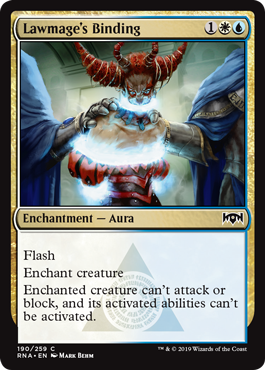
What it lacks in rares, Azorius more than makes up for with powerful commons and uncommons. The deck has plenty of flyers at its disposal: like Simic, it can use Chillbringer to gain a tempo advantage in the mid-game; combined with Senate Griffin and Windstorm Drake, the Azorius deck has an air force to be reckoned with. The deck also has access to great common removal spells, such as Lawmage’s Binding and Summary Judgment, and its Guildmage is arguably the best in the whole cycle.
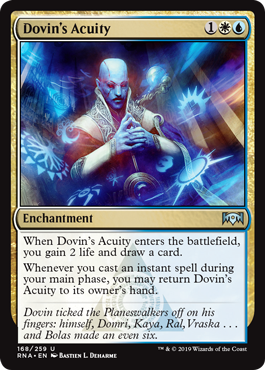
Azorius also has access to some extremely powerful “build-around” enchantments at uncommon. Dovin’s Acuity is Azorius’s Disinformation Campaign, and it’s especially effective if you have several copies of Summary Judgment. High Alert, initially written off as a Constructed-only card, has also proved its worth – for best results, combine with Wall of Lost Thoughts, Senate Courier, Azorius Knight-Arbiter, and/or Sentinel’s Mark.
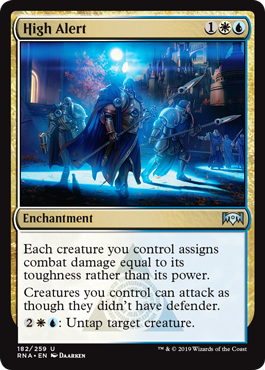
No matter how your build it, Azorius has an ability to go over the top that other decks lack. Don’t sleep on this deck – it’s more powerful than it looks.
ORZHOV
Orzhov has been and remains one of the most popular decks in RNA limited. Unlike Azorius, Orzhov had some of the flashiest rares and mythics in the set – including Ethereal Absolution and Seraph of the Scales – but its commons and uncommons are what give it staying power.
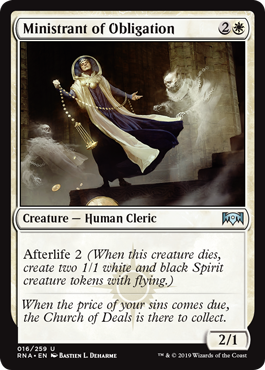
The Afterlife mechanic has obvious strengths in limited. In a format based on creature combat and resource management, creatures that create other creatures when they die are extremely powerful. Imperious Oligarch is a relatively high pick, and Ministrant of Obligation is a slam dunk. While there are a handful of cheap exile effects in the format – including Scorchmark and Grotesque Demise at common – you’ll often have more creatures with Afterlife than your opponent has effective ways to deal with them.
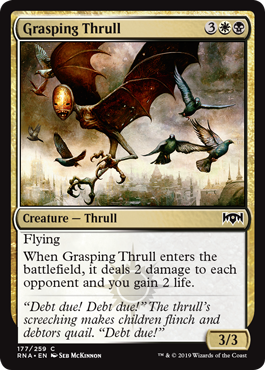
Like Azorius and Simic, Orzhov can also play well as a flyers deck. Grasping Thrull provides a significant life swing and can start chipping in for damage, especially if you can back it up with some of Orzhov’s great common removal spells. The spirit tokens from Afterlife can also get those last few points of damage in or trigger Spectacle; I like to play a copy of Dead Revels in my Orzhov decks to get more value out of Afterlife creatures, and you can’t go wrong with Blade Juggler, either.
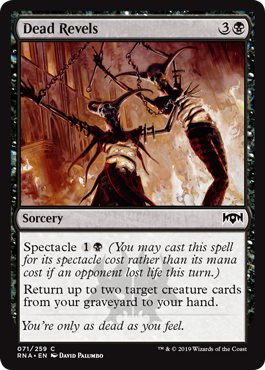
Orzhov decks can frequently gain life, stabilize, and grind out advantage over the course of the game. With good utility creatures, plentiful removal spells at common, and incremental life-gain from Ill-Gotten Inheritance, Orzhov can dominate games of RNA limited. Be prepared for it.
RAKDOS
Finally, we’ve come to Rakdos – one of the more misunderstood decks in RNA limited. Though it was popular at the outset, Rakdos fell behind in many players’ rankings due to lack of staying power. Unlike Boros in GRN draft, Rakdos can’t go over the top with flyers or turn the tables with Cosmotronic Wave; it’s much more fragile and behaves more like a traditional aggro deck.
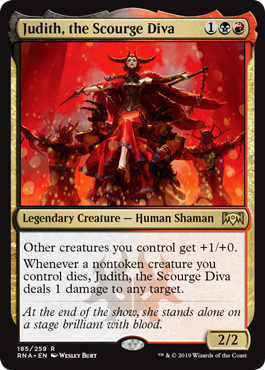
Like some of the other decks we’ve covered, Rakdos gets a big boost from its higher-rarity cards. Rakdos, Judith, Captive Audience, and Spawn of Mayhem are all compelling reasons to draft this archetype, so don’t be afraid to first-pick them. Rakdos Firewheeler is also an incredible uncommon and a great way to top off your creature curve.

The secret to a good Rakdos deck appears to be keeping the curve low and the damage output high. Most successful Rakdos decks play sixteen lands and rely on spells with low Spectacle costs. Blade Juggler is the deck’s premier common, providing a crucial source of card advantage. It’s great in multiples, as are direct damage spells like Skewer the Critics.
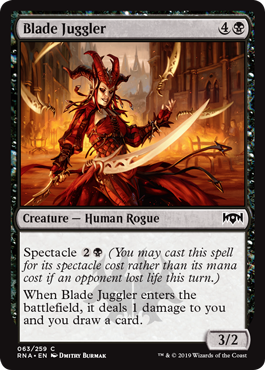
Though it can struggle with opponents’ sideboard plans in Traditional Draft, a fast Rakdos deck will frequently catch opponents unaware in Ranked. Get in for damage early and you’ll be sure to make quite a Spectacle.
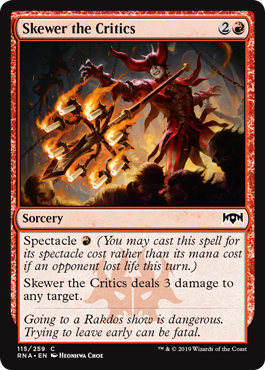
Phew! We covered all six major archetypes of Ravnica Allegiance limited. All six have their merits; it’s up to you to navigate your draft well and identify the open strategy.
Be sure to share your RNA draft stories with us on social media – we’d love to see some of your best decks or hear about your worst beats. And if you’d like to play RNA in person with friends, be sure to pick up a booster box at CardKingdom.com. Happy drafting!

Hallie served as Content Manager for CardKingdom.com and editor-in-chief of the Card Kingdom Blog from 2017-2022. Part tournament grinder, part content creator, Hallie is always looking for ways to improve her game and to share what she learns with others.

